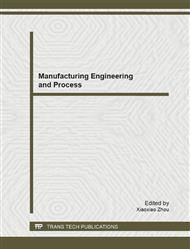[1]
Bikramaditya Das and Susmita Das, "Rake-MMSE time domain equalizer for high data rate UWB communication system," 2009 Annual IEEE India Conference (INDICON), p.1–4, 2009.
DOI: 10.1109/indcon.2009.5409346
Google Scholar
[2]
Susmita Das and Bikramaditya Das, "Time domain equalization technique using Rake-MMSE receivers for high data rate UWB communication system," 2009 First International Conference on Networks & Communications, p.1249–1253, 2009.
DOI: 10.1109/netcom.2009.51
Google Scholar
[3]
Takizawa, K. and Kohno, R., "Low-complexity Rake receptionand equalization for MBOK DS-UWB systems," IEEE Global Telecommunications Conference, p.271–350, 2004.
DOI: 10.1109/glocom.2004.1378156
Google Scholar
[4]
Eslami, M. and Xiaodai Dong, "Performance of Rake-MMSE-Equalizer for UWB communications," IEEE Wireless Communications and Networking Conference, vol. 2, p.855–860, 2005.
DOI: 10.1109/wcnc.2005.1424619
Google Scholar
[5]
Eslami, M. and Xiaodai Dong, "Rake-MMSE-Equalizer performance for UWB," IEEE Communications Letters, vol.9, 2, pp.502-504, 2005.
DOI: 10.1109/lcomm.2005.06004
Google Scholar
[6]
Zheng, Y. J., Ng, J.H., and Yang, L., "A low-complexity blind Rake combining equalizer for UWB communication systems," IEEE International Conference on Ultra-Wideband, p.629–633, 2006.
DOI: 10.1109/icu.2006.281621
Google Scholar
[7]
Wan Quan, and Anh Dinh, "An N-selective MRC Rake receiver with LMS adaptive equalizer for UWB systems," Canadian Conference on Electrical and Computer Engineering, p.1783–1786, 2006.
DOI: 10.1109/ccece.2006.277847
Google Scholar
[8]
Sheng-Lun Chiou, and Ming-Xian Chang, "Analysis of DS-UWB with MMSE equalization in dispersive channels," International Conference on Wireless Communications, Networking and Mobile Computing, p.1–4, (2006)
DOI: 10.1109/wicom.2006.111
Google Scholar
[9]
Ren-Jr Chen, and Chang-Lan Tsai, "Design and performance analysis of the receivers for DS-UWB communication systems," IEEE International Conference on Ultra-Wideband, p.651–656, 2006.
DOI: 10.1109/icu.2006.281625
Google Scholar
[10]
Quan Wan, and Anh Dinh, "MRC-Rake-LMS-Equalizer performance for UWB," 10th IEEE Singapore International Conference on Communication systems, p.1–5, 2006.
DOI: 10.1109/iccs.2006.301444
Google Scholar
[11]
Zhenyu Xiao, Liang Zhu, Ning Ge, and Lieguang Zeng, "The optimum SRake based Rake-DFE receiver for carrier DS-UWB systems," 11th IEEE Singapore International Conference on Communication Systems, p.1529–1533, 2008.
DOI: 10.1109/iccs.2008.4737439
Google Scholar
[12]
Yu-Hao Chang, Shang-Ho Tsai, Xiaoli Yu, and Kuo, C.-C.J., "Performance enhancement of channel-phase precoded ultra-wideband (CPP-UWB) systems by Rake receivers," IEEE Global Telecommunications Conference, p.1–5, 2008.
DOI: 10.1109/glocom.2008.ecp.667
Google Scholar
[13]
Boubaker N., and Letaief K.B., "A low complexity MMSE-Rake receiver in a realistic UWB channel and in the presence of NBI," IEEE Wireless Communications and Networking, vol.1, p.233–237, 2003.
DOI: 10.1109/wcnc.2003.1200351
Google Scholar
[14]
Honsan Sheng, Haimovich A.M., Molisch A.F., amd Jinyun Zhang, "Optimum combining for time hopping impulse radio UWB rake receivers," IEEE Conference on Ultra Wideband Systems and Technologies, p.224–228, 2003.
DOI: 10.1109/uwbst.2003.1267837
Google Scholar
[15]
Gezici S., Mung Chiang, Poor H.V., and Kobayashi H., "A genetic algorithm based finger selection scheme for UWB MMSE Rake receivers," IEEE International Conference on Ultra-Wideband, p.164–169, 2005.
DOI: 10.1109/icu.2005.1569977
Google Scholar
[16]
Gezici S., Mung Chiang, Poor H.V., and Kobayashi H., "Optimal and suboptimal finger selection algorithms for MMSE Rake receivers in impulse radio ultra-wideband systems," IEEE Wireless Communications and Networking Conference, vol.2, p.861–866, 2005.
DOI: 10.1109/wcnc.2005.1424620
Google Scholar
[17]
Chen R., Po-Lin Chiu, and Hua-Lung Yang, "Design and performance analysis of DS-UWB Rake receiver," IEEE International Symposium on Circuits and Systems, p.4715–4718, 2006.
DOI: 10.1109/iscas.2006.1693683
Google Scholar
[18]
oubaker N., and Letaief K.B., "MMSE multipath diversity combining for multi-access TH-UWB in the presence of NBI," IEEE Transactions on Wireless Communications, vol.5, 4, p.712–719, 2006.
DOI: 10.1109/twc.2006.1618917
Google Scholar
[19]
Theriault M., Rusch L.A., Roy S., and Fortier P., "A semi-analytic method for BER performance of Rake-based UWB receivers," IEEE Wireless Communications and Networking Conference, p.112–117, 2008.
DOI: 10.1109/wcnc.2008.25
Google Scholar


